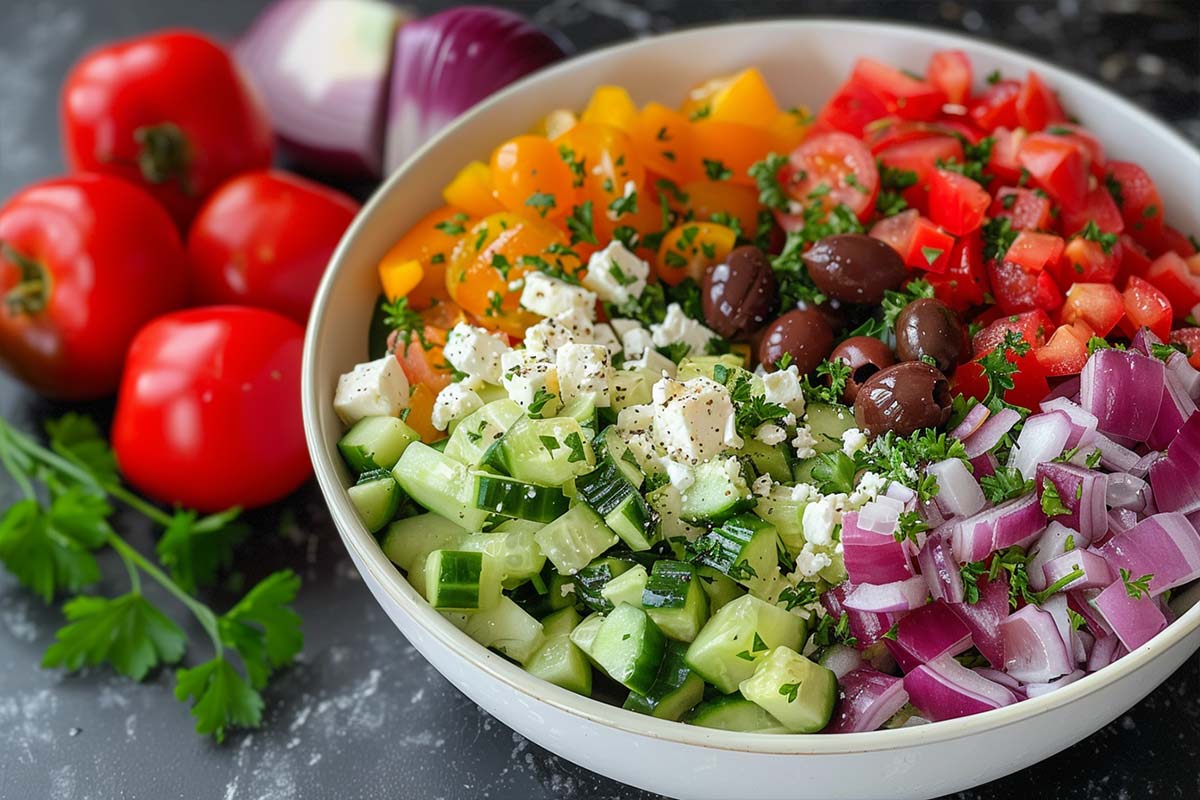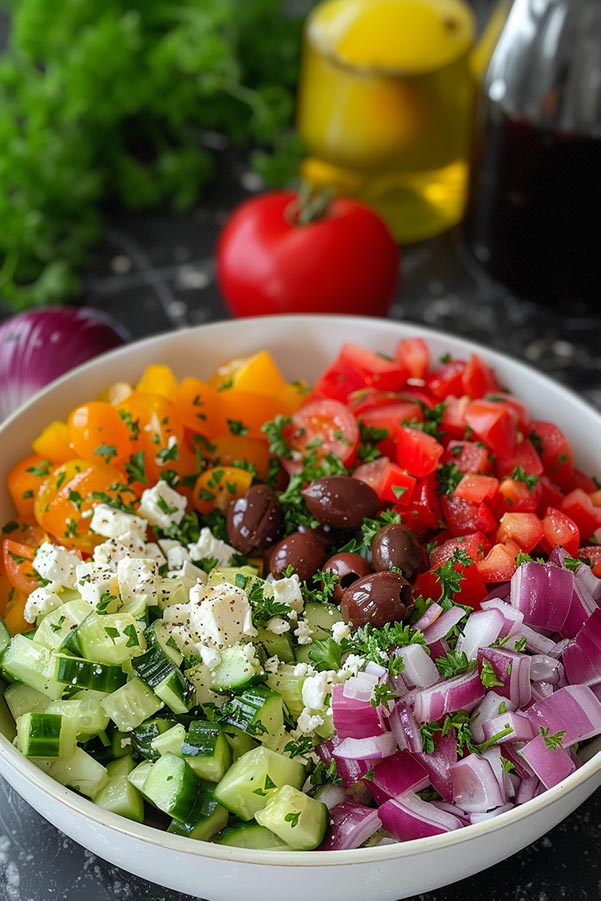The Greek salad holds a prominent place in Greek cuisine, having gained popularity since the 19th century when the advent of tomatoes influenced its creation. This delightful salad has transcended borders and is now recognized and relished both within and beyond Greece. It has earned a beloved status as a renowned dish across the globe. When people visit Greece, one of the most frequently requested culinary delights is the Greek salad. Its appeal lies not only in its healthfulness and freshness but also in its irresistible taste.
So what makes Greek salad so special? What do you need to make a Greek salad? Below, we will share everything you need to know about Greek Salad, from what you need to make Greek salad to how to make Greek salad dressing to help you make an authentic Greek salad in the comfort of your home.

The Best Greek Salad Recipe
Prep Time
10 minutes
Cook Time
0 minutes
Rest Time
15 minutes
Total Time
25 minutes
The Salad
Ingredients
Directions
1. Wash and prepare the vegetables: Cut the tomatoes into wedges or chunks, peel and slice the cucumber, thinly slice the red onion, and dice the bell peppers. Place them all in a large salad bowl that is large enough to toss the salad.
2. Add the Kalamata olives: Pit the Kalamata olives if necessary and add them to the salad bowl.
3. Crumble the feta cheese: Crumble the feta cheese over the vegetables in the bowl. You can customize the quantity of feta according to your personal preference.
Homemade Greek Salad Dressing
Ingredients
Directions
1. In a separate small bowl, whisk together the extra-virgin olive oil, red wine vinegar, and lemon juice in a small bowl until well combined.
2. Add the minced garlic and dried oregano to the bowl and continue whisking until the dressing is smooth and well-mixed.
3. Season with salt and pepper to taste. Remember to start with a small amount and adjust according to your preference.
4. Give the dressing a final whisk to guarantee thorough incorporation of all the ingredients.
5. Allow the dressing to rest for a minimum of 15 minutes before using it, allowing the flavors to blend harmoniously.
6. Give the dressing a quick stir or shake before using it on your Greek salad.

Tips/ Notes
Cut ingredients into similar sizes: Aim for uniformity in the size of the vegetables to ensure consistent flavors and an appealing presentation.
Don't overdress the salad: Begin with a modest amount of dressing and gradually increase as necessary. The dressing should lightly coat the ingredients without overpowering them.
Consider toppings: To add an extra touch, you can add toasted pita bread, roasted nuts, or seeds to add texture and flavor to the salad.
Garnish with fresh herbs: Sprinkle some fresh parsley, basil, or mint over the salad for an added burst of freshness and aroma.
Nutritional Facts
Nutrition Facts
Servings: 4
Calories
272
% Daily Value*
Total Fat 23g
29%
Saturated Fat 6.6g
33%
Cholesterol 25mg
8%
Sodium 554mg
24%
Total Carbohydrate 13g
5%
Dietary Fiber 2.7g
10%
Total Sugars 7.3g
Protein 6g
Vitamin D 0mcg
0%
Calcium 178mg
14%
Iron 1mg
6%
Potassium 414mg
9%
*The % Daily Value (DV) tells you how much a nutrient in a food serving contributes to a daily diet. 2,000 calorie a day is used for general nutrition advice.
What Is A Greek Salad
The Greek salad, referred to as "Horiatiki" in Greece, is an authentic dish that traces its origins back to Greek cuisine. It is believed to have its roots in the rural Greek countryside, where farmers and villagers would use the fresh ingredients readily available to them.
While the origin and history of the Greek salad are not definitively documented, it is commonly believed that it has been a part of Greek culinary heritage for centuries. Over the years, it has transformed and cemented its position as a fundamental element in Greek homes and dining establishments.
As we know it today, the modern version of the Greek salad gained popularity in the 20th century. The use of tomatoes in the salad is attributed to this ingredient's rising popularity and availability in Greece in the late 19th century. Adding tomatoes brought a burst of color and juiciness to the salad, enhancing its appeal.
The Greek salad has emerged as a globally recognized culinary delight, renowned within Greece and beyond its borders. It is appreciated for its simplicity, freshness, and its showcase of the Mediterranean region's flavors. While the Greek salad has become popular worldwide, it remains deeply rooted in Greek culinary culture. It continues to be enjoyed as a beloved traditional dish representing Greek cuisine's essence.
Greek salad combines fresh vegetables, herbs, cheese, olives, and a simple dressing, all of which create a harmonious and flavorful dish. Here are the key components of a Greek salad:
Tomatoes: Ripe, juicy tomatoes are a crucial element of a Greek salad, providing a sweet and tangy flavor.
Cucumbers: Crisp cucumbers add a refreshing crunch to the salad, balancing out the flavors.
Red onions: Sliced or diced red onions bring a mild, savory taste and a hint of pungency to the salad.
Kalamata olives: These dark, meaty olives are a staple in Greek cuisine and add a rich, briny flavor to the salad.
Feta cheese: Feta, a crumbly and tangy Greek cheese made from sheep's milk, is a highlight of the salad, providing a creamy and salty taste.
Bell peppers: Vibrant bell peppers, usually green or red, contribute a subtle sweetness and a pleasant crunch.
Herbs and seasonings: Fresh herbs like oregano and parsley are often sprinkled on the salad for added aroma and flavor. Salt and pepper may be used to taste.
The Greek Salad Dressing
Greek salad dressing is a key component that adds a burst of flavor and richness to the Greek salad. It is a simple yet delicious dressing that complements the fresh veggies and cheese in the salad.
The key components of Greek salad dressing consist of extra-virgin olive oil, red wine vinegar, lemon juice, minced garlic, dried oregano, salt, and pepper. When combined, these ingredients harmonize to deliver a tangy, zesty, and herbaceous flavor that elevates the overall taste experience.
What You Will Need To Make A Traditional Greek Salad
Regardless of what Greek salad recipe you are following to make a Greek salad, there is a list of Greek salad ingredients that you will need:
Tomatoes
Ripe and juicy tomatoes are a key component of a Greek salad. Depending on your preference, you can choose beefsteak tomatoes, Roma tomatoes, or cherry tomatoes.
Greek salads often feature the popular choice of beefsteak tomatoes, renowned for their robust flavor and firm texture, which adds great stability to the salad.
Roma tomatoes, or plum tomatoes, are commonly included in Greek salads. Although they are less juicy, they offer a delightful richness and sweetness that harmonizes beautifully with the other components.
If you prefer a smaller tomato variety, cherry or grape tomatoes can be used in a Greek salad. They offer a burst of sweetness and add vibrant color to the salad.
Cucumbers
Crisp and refreshing cucumbers are other essential ingredients. In Greek salads, it is common to incorporate English cucumbers, which are alternatively referred to as hothouse or seedless cucumbers. They are a preferred choice because of their crisp texture, mild flavor, and thin skin, eliminating the need for peeling. English cucumbers have fewer seeds than other varieties, making them ideal for slicing into thin rounds or half-moons for salad.
Red Onion
Thinly sliced red onion gives the salad a mild and tangy flavor, and you can adjust the quantity to suit your taste preferences.
Kalamata Olives
Kalamata olives are a traditional and popular choice for Greek salad. They are dark purple or black olives that are native to Greece and are known for their distinctive flavor and meaty texture. Kalamata olives have a rich, fruity taste with a slightly bitter undertone, adding depth and complexity to the salad.
If Kalamata olives are not available, you can use black olives instead. While Kalamata olives are the more traditional option, some variations of Greek salad may include black olives. Black olives, such as the popular canned variety, are milder in flavor than Kalamata olives and have a less pronounced taste and a softer texture.
Feta Cheese
The creamy and tangy feta cheese is a highlight of a Greek salad. While traditionally crafted from sheep's milk, you can also find versions made with cow's milk. Crumble or dice the feta cheese and sprinkle it generously over the salad.
Green Bell Peppers
Green bell pepper or red bell pepper adds color, crunch, and a subtle sweetness to the salad. They can be thinly sliced or chopped.
Extra-Virgin Olive Oil
A high-quality extra-virgin olive oil is essential for dressing and drizzled over the salad.
Red Wine Vinegar
This vinegar provides acidity and tanginess to the salad, and it's often used in dressing.
Fresh Lemon Juice
Freshly squeezed lemon juice adds brightness and freshness to the salad, and it can be used in both the dressing and as a final squeeze over the salad.
Dried Oregano
This herb is a staple in Greek cuisine and is sprinkled over the salad to infuse it with a Mediterranean flavor.
Salt And Pepper
These seasonings elevate the flavors and can be incorporated according to personal preference.

How To Elevate A Greek Salad
Use heirloom tomatoes: Instead of regular tomatoes, choose colorful tomatoes with varying shapes, sizes, and flavors. These unique tomatoes add visual appeal and a deeper, more complex taste to the salad.
Add fresh herbs: Along with the traditional dried oregano, add herbs such as fresh oregano, basil, mint, or dill to the salad. They bring vibrant aromas and enhance the overall freshness of the dish.
Experiment with different cheeses: While feta cheese is the classic choice for a Greek salad, you can elevate the salad by exploring other Greek cheeses. Try using creamy and tangy cheeses like goat cheese or tangy Graviera cheese for a unique twist.
Add a protein: To make the Greek salad more substantial and satisfying, incorporate a protein source such as grilled chicken, shrimp, or chickpeas. This addition adds extra nutrition and transforms the salad into a complete meal.
Toasted pita chips or croutons: For a satisfying crunch, add homemade toasted pita chips or croutons to the Greek salad. These crunchy elements elevate the texture and provide a delightful contrast.

